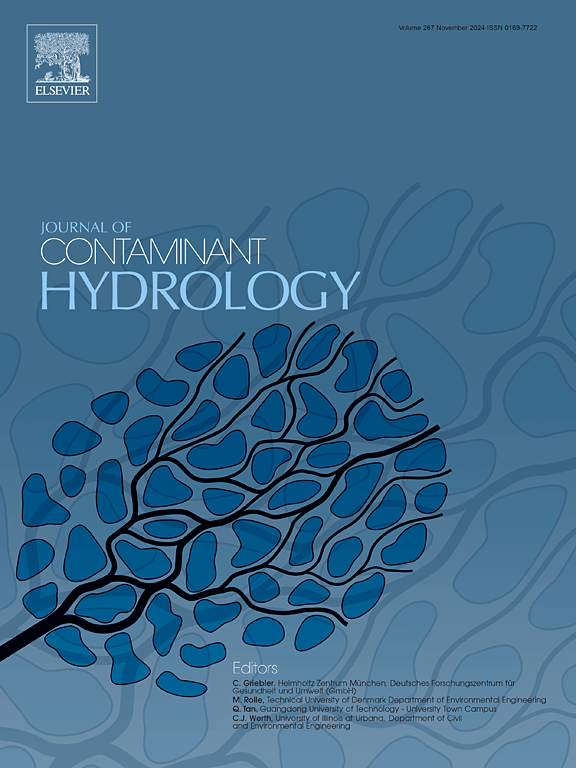采砂影响下湖泊沉积物导电性、水文连通性空间异质性及成因分析——以典型大型采砂湖(鄱阳湖)为例
IF 3.5
3区 环境科学与生态学
Q2 ENVIRONMENTAL SCIENCES
引用次数: 0
摘要
采砂工程将改变沉积物的饱和水力导度(K),它是决定地表水-沉积物-含水层系统连通性和岸线稳定性的重要参数。然而,对采砂活动影响下湖泊沉积物K值及水文连通性的研究仍然有限。本研究在全球最大的采砂湖(鄱阳湖)进行了90个竖管试验,测量了不同方向的湖床沉积物K。利用地质统计学、连通性指数和遥感分析了鄱阳湖钾的空间异质性、水文连通性和采砂效应。结果表明,鄱阳湖钾的空间变异性较强。Kv, Ks, Kh变化从1.85×10 6到9.43×10−−2厘米/秒,3.63×10 6到9.95×10−−2厘米/秒,1.29×10−6到5.16×10−2 cm / s。Kv、Ks和Kh的高斯模型与实验变异曲线拟合最好。鄱阳湖沉积物主要由粉砂、粉质壤土、砂质壤土和壤土组成。水文连通性指数在- 29 ~ 35之间变化。d20和d50与K的相关性最强,幂函数模型是K与特征粒度的最佳拟合模型。大型采砂工程通过改变沉积物颗粒组成、地貌类型、地下水深度和水动力条件,影响K的非均质性和水文连通性。研究结果为类似大型采砂湖的湖泊沉积物渗透性研究、采砂工程管理和边坡失稳防治提供了重要参考。本文章由计算机程序翻译,如有差异,请以英文原文为准。

Spatial heterogeneity of lake sediment hydraulic conductivity, hydrological connectivity and causes analysis under the influence of sand mining activities: In-situ tests in a typical large sand mining lake (Poyang lake)
Sand mining engineering will change the saturated hydraulic conductivity (K) of sediments, which is an important parameter determining the connectivity of surface water-sediment-aquifer system and the stability of shoreline. However, the research about K and hydrological connectivity of lake sediment under the influence of sand mining activities is still limited. In this study, 90 standpipe tests were conducted in the global largest sand mining lake (Poyang Lake) to measure K of lakebed sediment in different directions. Geostatistics, connectivity index and remote sensing were used to analysis the spatial heterogeneity of K, hydrological connectivity and sand mining effect on K. Results showed that the spatial variability of K was strong in Poyang Lake. Kv, Ks, Kh varied from 1.85 × 10−6 to 9.43 × 10−2 cm/s, 3.63 × 10−6 to 9.95 × 10−2 cm/s, 1.29 × 10−6 to 5.16 × 10−2 cm/s. Gaussian model of Kv, Ks and Kh fitted the experimental variogram best. Poyang Lake sediments were composed of silt, silty loam, sandy loam and loamy sand. Hydrological connectivity index varied from −29 to 35 among the test points. d20 and d50 had the strongest correlation with K. Power function model was the best fitting model of K and characteristic grain size. Large-scale sand mining engineering affected the heterogeneity of K and hydrological connectivity by changing sediment grain composition, geomorphic type, groundwater depth and hydrodynamic conditions. The results provide important references for lake sediment permeability researching, sand mining engineering management and slope instability prevention in similar large sand mining lakes.
求助全文
通过发布文献求助,成功后即可免费获取论文全文。
去求助
来源期刊

Journal of contaminant hydrology
环境科学-地球科学综合
CiteScore
6.80
自引率
2.80%
发文量
129
审稿时长
68 days
期刊介绍:
The Journal of Contaminant Hydrology is an international journal publishing scientific articles pertaining to the contamination of subsurface water resources. Emphasis is placed on investigations of the physical, chemical, and biological processes influencing the behavior and fate of organic and inorganic contaminants in the unsaturated (vadose) and saturated (groundwater) zones, as well as at groundwater-surface water interfaces. The ecological impacts of contaminants transported both from and to aquifers are of interest. Articles on contamination of surface water only, without a link to groundwater, are out of the scope. Broad latitude is allowed in identifying contaminants of interest, and include legacy and emerging pollutants, nutrients, nanoparticles, pathogenic microorganisms (e.g., bacteria, viruses, protozoa), microplastics, and various constituents associated with energy production (e.g., methane, carbon dioxide, hydrogen sulfide).
The journal''s scope embraces a wide range of topics including: experimental investigations of contaminant sorption, diffusion, transformation, volatilization and transport in the surface and subsurface; characterization of soil and aquifer properties only as they influence contaminant behavior; development and testing of mathematical models of contaminant behaviour; innovative techniques for restoration of contaminated sites; development of new tools or techniques for monitoring the extent of soil and groundwater contamination; transformation of contaminants in the hyporheic zone; effects of contaminants traversing the hyporheic zone on surface water and groundwater ecosystems; subsurface carbon sequestration and/or turnover; and migration of fluids associated with energy production into groundwater.
 求助内容:
求助内容: 应助结果提醒方式:
应助结果提醒方式:


